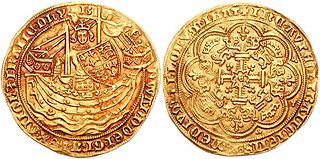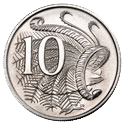
A coin is a small object, usually round and flat, used primarily as a medium of exchange or legal tender. They are standardized in weight, and produced in large quantities at a mint in order to facilitate trade. They are most often issued by a government. Coins often have images, numerals, or text on them. The faces of coins or medals are sometimes called the obverse and the reverse, referring to the front and back sides, respectively. The obverse of a coin is commonly called heads, because it often depicts the head of a prominent person, and the reverse is known as tails.

The standard circulating coinage of the United Kingdom, British Crown Dependencies and British Overseas Territories is denominated in pennies and pounds sterling, and ranges in value from one penny sterling to two pounds. Since decimalisation, on 15 February 1971, the pound has been divided into 100 (new) pence. Before decimalisation, twelve pence made a shilling, and twenty shillings made a pound.

The noble was the first English gold coin produced in quantity, introduced during the second coinage (1344–1346) of King Edward III. It was preceded by the gold penny and the florin, minted during the reign of King Henry III and the beginning of the reign of King Edward III; these saw little circulation. The derivatives of the noble, the half noble and quarter noble, on the other hand, were produced in quantity and were very popular.

The British florin, or two-shilling piece, was a coin worth 1⁄10 of one pound, or 24 pence. It was issued from 1849 until 1967, with a final issue for collectors dated 1970. It was the last coin circulating immediately prior to decimalisation to be demonetised, in 1993, having for a quarter of a century circulated alongside the ten-pence piece, identical in specifications and value.

The British threepence piece, usually simply known as a threepence, thruppence, or thruppenny bit, was a denomination of sterling coinage worth 1⁄80 of one pound or 1⁄4 of one shilling. It was used in the United Kingdom, and earlier in Great Britain and England. Similar denominations were later used throughout the British Empire and Commonwealth countries, notably in Australia, New Zealand and South Africa.

Obverse and its opposite, reverse, refer to the two flat faces of coins and some other two-sided objects, including paper money, flags, seals, medals, drawings, old master prints and other works of art, and printed fabrics. In this usage, obverse means the front face of the object and reverse means the back face. The obverse of a coin is commonly called heads, because it often depicts the head of a prominent person, and the reverse tails.

The Gobrecht dollar, minted from 1836 to 1839, was the first silver dollar struck for circulation by the United States Mint after production of that denomination had been halted in 1806. The coin was struck in small numbers to determine whether the reintroduced silver dollar would be well received by the public.
This glossary of numismatics is a list of definitions of terms and concepts relevant to numismatics and coin collecting, as well as sub-fields and related disciplines, with concise explanations for the beginner or professional.
Upper Canada had a short history as a coin-issuing entity.

The Australian ten-cent coin is a coin of the decimal Australian dollar. When the dollar was introduced as half of an Australian pound on 14 February 1966, the coin inherited the specifications of the pre-decimal shilling; both coins were worth one twentieth of a pound and were called "bob". On introduction it was the fourth-lowest denomination coin. Since the withdrawal from circulation of the one and two cent coins in 1992, it has been the second-lowest denomination coin in circulation.
The coins of Canada are produced by the Royal Canadian Mint and denominated in Canadian dollars ($) and the subunit of dollars, cents (¢). An effigy of the reigning monarch always appears on the obverse of all coins. There are standard images which appear on the reverse, but there are also commemorative and numismatic issues with different images on the reverse.

The British halfpenny coin was worth 1/480th of a pound sterling. At first in its 700-year history it was made from silver, but as the value of silver increased the coin was made from base metals. It was finally abandoned in 1969 as part of the process of decimalising the British currency. "Halfpenny", colloquially written ha'penny, was pronounced HAY-pə-nee; "1 ½d" was spoken as a penny ha'penny or three ha'pence.
The coins of the Australian dollar were introduced on 14 February 1966, although they did not at that time include the one-dollar or two-dollar coins. The dollar was equivalent in value to 10 shillings in the former currency.

The shilling, informally called a "bob", was a type of silver coinage issued by the Commonwealth of Australia, that circulated prior to the decimalisation of Australian coinage. The Australian shilling was derived from the British pre-decimal sterling pound system and was first issued following the passing of the Australian Coinage Act 1909, which established Australia's first formal currency system. The shilling was issued as part of Australia's silver coinage, which included the two-shilling (florin), the sixpence and the threepence. The shilling was minted from 1910 until 1963. During this period there was one significant modification to the design of the Australian shilling, the change in its reverse design, which occurred in 1938 when the design was altered from the Australian Coat of Arms (1910–1936) to the visage of a Merino ram’s head (1938–1963).
Alex Shagin is a coin designer.

Medieval Bulgarian coinage were the coins minted by the Bulgarian Emperors during the Middle Ages at the time of the Second Bulgarian Empire.
Donald Nelson Everhart II is an American coin and medal engraver-medalist, and sculptor who has worked for the private Franklin Mint, as a freelance designer, and since 2004 has worked for the United States Mint in Philadelphia. With over 1,000 models for coins and medals attributed to him as of 2008, he is still at the prime of his career creating the bas-relief models for these and similar sculptural objects. His coin designs are in the pockets of American citizens, and despite his late arrival to the series of the popular U.S. Statehood Quarters, he has designed and modeled three State's unique reverse designs, modeled three others, and six U.S. commemorative coins. His portrait of President William Clinton was chosen for Clinton's second term Inaugural Medal. Among his other medal creations are six Congressional Gold Medals for the U.S. Mint, seven Society of Medalists issues, twelve calendar medals, and other models for private medal makers, as well as cast art medals.
Minting, coining or coinage is the process of manufacturing coins using a kind of stamping, the process used in both hammered coinage and milled coinage. This "stamping" process is different from the method used in cast coinage.
The 50 sen coin (五十銭硬貨) was a Japanese coin worth half of a Japanese yen, as 100 sen equalled 1 yen. These coins circulated from the late 19th century to the early 1950s, when Japan adopted a single currency unit and this coin was demonetized.
The 10 sen coin (十銭硬貨) was a Japanese coin worth one tenth of a Japanese yen, as 100 sen equalled 1 yen. These coins were minted from the late 19th century up until the end of World War II.









